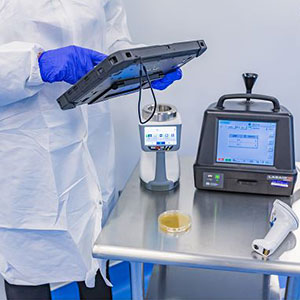ISO TR 14644 21: Airborne particle sampling techniques.
The Technical Committee (ISO/TC209) responsible for ISO 14644, the set of Standards governing cleanrooms and associated controlled environments, looked at the need for a new document to aid users in the application of airborne particle counters; especially considering the new revision to EU Annex 1 – Manufacture of Sterile Medicinal Products (2022). The Technical Report (TR) describes the application of particle counters for classification and monitoring to provide sufficient proof that the cleanroom performance both meets the required standard and is demonstrated to be maintained within ‘normal’ operating conditions.
The ISO TR 21 document, written by the committee including Mark Hallworth (one of the committee members) directly looks at those applications where particles less than 5.0 µm are important as part of an overall sampling program and not singularly those applications that are only looking at large, macro particles (>5.0 µm). It reviews the misinterpretation of clause C.4.1.2 in Annex C of ISO 14644-1, which suggests the use of 1 m tubing length for sampling macroparticles. The purpose of clause C.4.1.2 is to also describe the importance of additional functions of interpreting and understanding,
- For classification where accuracy is required, the quality of the sample is important.
- For monitoring where trending is important in understanding control, the quality of the data is important.
- Direct sampling without tubing is ideal, but sample tubing can be necessary to take a sample where it is not possible to position the instrument directly, and this tubing should be as short as is feasible.
- A sampling system (inlet probe, tubing, connectors and valves, and instrument) needs to be considered in evaluating the impact of data generated.
When we look at the spectrum of use for the particle counter it includes both classification and monitoring, and the TR set out to better describe those differences. In classification, ISO 14644 Part 1 does not provide for the classification of particle populations that are outside the table (0.1 μm to 5 μm). In monitoring, a particle counter is used to demonstrate that those particle levels associated with typical conditions do not shift from the expected range of results; these may be defined based on historical data trends. The relationship between the data gained at each phase of use is shown in Figure 1.

Figure 1: Strategy for Contamination Control
Complete the form to download a copy of the full paper and learn more about ISO 14644-21 and to get a decision tree to help you make decisions within your application.
Get the experts in Particle Measuring Systems’ Advisory team to do your risk assessment for tubing particle loss.
Particle loss in transport tubing can occur due to a combination of various external factors. To assess the risk and potential impact on the finished product, it is crucial to conduct particle transportation tests. The primary objective of these tests is twofold: first, to quantify the resultant particle losses within a remote sampling system, and second, to provide documented evidence characterizing the efficiency of viable and non-viable monitoring processes. By addressing these aspects, manufacturers can gain valuable insights into the particle transportation dynamics in their remote systems and ensure appropriate measures are taken to maintain product quality.



